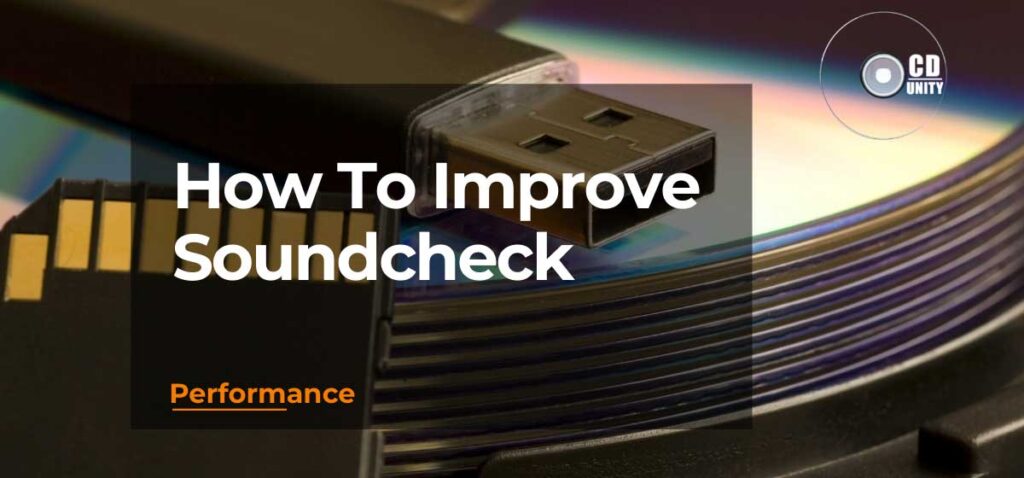
How To Improve Your Soundcheck: Simple Soundcheck Hacks
For musicians, soundchecks are an essential part of any live gig.
As such, being well-prepared and having the right know-how can make or break your performance.
Learn how to get the most out of your own sound checks with our guide, ranging from simple tips on communication and organisation to advanced techniques enhanced by effects processing and mic placement.
Quick Facts
- Being prepared, organised and rehearsing prior to the soundcheck is essential for a successful performance.
- Establish an effective communication between musicians and sound engineers using verbal cues or hand signals to communicate what adjustments need to be made during the check.
- Knowing your gear inside out allows fast access to getting ready for shows without needing additional sound check time with experts.
- Building positive relationships with sound engineers further helps build trust by understanding each other’s creative vision and smoothing transitions during live sets.
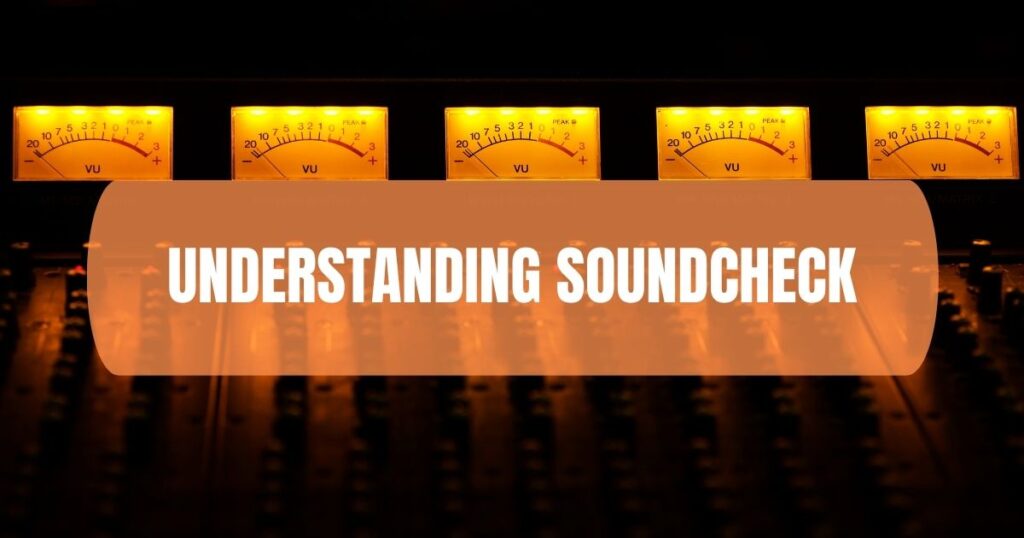
Understanding Soundcheck
Soundcheck is a crucial part of every performance, allowing the sound engineer to prepare and adjust instruments and equipment for optimal live sound.
Importance Of Soundcheck For Musicians
As a musician, soundcheck is essential for achieving the best possible performance in your live gigs. At a minimum, it allows you to check that all equipment is working correctly and ensure optimal sound from the house speakers and stage monitors.
However, when done right, soundcheck can be much more than an obligation – it can be an incredible opportunity for band members to bond with their sound engineer.
It’s also vital in helping build trust between performers and technicians, as well as providing guidance on setting up a mix that will work effectively throughout any show.
During soundcheck, each part of your set needs to be tested thoroughly so you’re sure that everything sounds great onstage; this includes checking frequencies/echoes or making positional adjustments when necessary.
What Happens During Soundcheck
During soundcheck, engineers spend time making sure microphones are in place, verifying settings on EQs, tuning amplifiers or DI units and running through check songs to ensure all parts of the stage mix blend together harmoniously.
It’s also important for musicians and singers during this process so that they can familiarise themselves with monitors set-ups, correctly assess if their instrument levels sit well in the mix – both loud enough but not too dominant compared to other instruments onstage – as well as gain confidence that their vocals cut through correctly without overbearing boominess.
A good sound check helps build performers’ trust in the engineer who will be helping them create an amazing audience experience using excellent sounding equipment on stage.
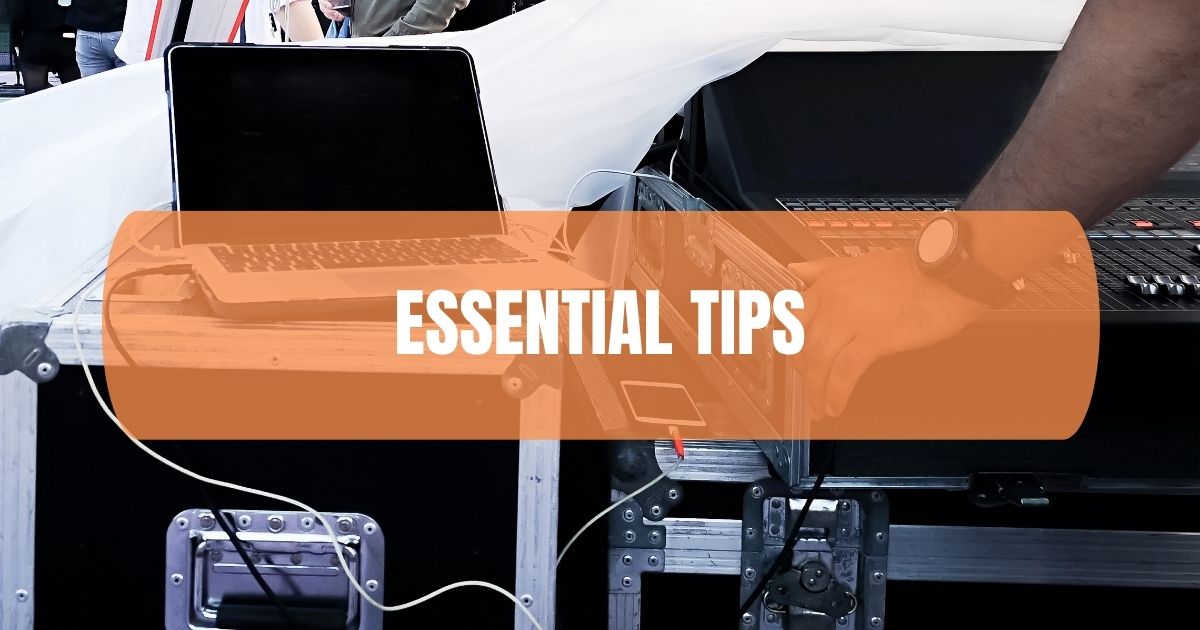
Essential Tips For A Successful Soundcheck
Gearing up with the right preparation, knowing your equipment and settings, forming a positive relationship with the sound engineer as well as collaborating with the band can go a long way in achieving successful soundchecks.
Let’s look into them.
Being Prepared And Organised
Preparation can make the difference between sounding great and struggling to deliver the best performance, especially if time is limited in the rehearsal room or studio.
Preparing beforehand by having a detailed set list, ensuring that all instruments are tuned and ready to be played on stage, keeping patch cables checked for any crackles or interference before use – these are small actions which could go a long way towards maximising sound quality during sound checks.
Communicating with bandmates prior to the check is also essential in order to ensure everyone is clear about what will happen during their individual sections of songs.
Rehearsing parts, as well as full songs, can help iron out issues before getting onto the stage so that when it’s showtime, everything runs smoothly from start to finish.
Effective Communication With Sound Engineers
There are several different ways that musicians can communicate with engineers – hand signals, or verbal cues are two of the most important ways of expressing what adjustments need to be made for optimum sound quality.
Using hand signals is especially useful if you have quite a few people on stage – each player can give an indication as to whether more treble or bass should be added without having to speak individually into a vocal microphone, making for smoother transitions between songs.
Another tip when communicating with sound engineers during soundcheck is establishing a positive relationship beforehand; getting acquainted before rehearsals start ensures there’s already trust between everyone involved in terms of understanding one another’s creative vision, so no time gets wasted discussing ideas later down the line!
Knowing Your Gear And Settings
When setting up for a soundcheck, musicians should be familiar with their instruments, amplifiers, microphones, and cables.
In terms of understanding nuances between loudspeakers and monitors when playing live gigs, it’s key to become familiar with EQ techniques necessary to adjust frequencies where they may not work well together.
For bands frequently touring, this knowledge allows fast access to getting ready for shows without needing additional sound check time, with engineers compensating for lack of experience or mic placement/instrument tuning by band members, which results in great energy-saving productivity leading to more focus towards the good visual connection between crowd & artists instead!
Building A Positive Relationship With The Sound Engineer
Building positive relationships between band members and their assigned sound engineer during soundcheck will allow for more effective communication, as musicians can feel supported throughout this process.
This constructive partnership also allows each person to know what’s expected of them leading up to the show:
The musician can provide feedback accordingly, whereas the expert sound engineers will have all of their settings tested before it’s even time to play music.
Ultimately, building strong connections between bands and engineers ensures success not only in terms of creating better sounds but also helps pave the way for open communication within a team setting so that when mistakes happen (as they often do!), everyone involved knows how to quickly resolve issues since they are familiar with one another after previously working together effectively.
Examples like Foo Fighters trusting award-winning engineer John Woodward never just being able to concoct world-class guitar tones but offering excellent advice at every turn illustrate greatly how a positive relationship between performers & technicians leads positively towards great results both onstage & off;
By getting close (and knowing each other’s respective flaws) incredible improvements across both sides are made which ultimately roll out into memorable shows filled with true collaborative efforts from start-to-finish!
Listening To Feedback And Adjusting Accordingly
It’s essential for musicians to remain open-minded during their sound checks and be prepared to make adjustments according to suggestions from other members or guidance from the engineer.
It can be intimidating at first, but with practice — as well as trial and error — musicians will soon find that they are able to get great results when making changes based on feedback.
For example: Prioritizing balance between instruments is an integral part of getting a good mix, so working together with your fellow band members and engineers to achieve synergy should not be overlooked.
Staying Focused And Professional
During soundcheck, it’s not only important for individual musicians to be focused on what they’re playing but also to remain quiet when others are performing while paying attention to any feedback from the engineer or band leaders.
Disruptions such as talking loudly, phones ringing, or sudden movements can cause considerable distractions – leading to mistakes that may take twice as long to fix!
It’s also worthwhile having an understanding of basic volume monitoring techniques so every performer is able – at least theoretically –to address any issues regarding balance and mic monitoring levels themselves without involving the house engineer unnecessarily.
Ultimately remaining respectful toward other performers alongside maintaining focus will allow everyone can come out satisfied after each rehearsal and show!

Common Soundcheck Mistakes To Avoid
There are simple mistakes you can avoid during the soundcheck, and believe me, you do want to avoid them.
Being Late Or Disorganised
Being late or disorganised during a soundcheck can be one of the most common and detrimental mistakes that musicians make.
Not only will it delay your show and frustrate sound engineers, but it could also negatively impact the quality of your performance.
To ensure that you have a successful soundcheck, it’s important to allow yourself plenty of time to set up in advance, have a checklist ready for all equipment that needs testing, and to communicate effectively with both bandmates and the sound engineer throughout the process.
Arriving at least an hour early provides adequate time for setting up microphones, instruments, amplifiers etc., which should help reduce any potential delays further down the line.
Having a pre-soundcheck checklist not only ensures nothing is forgotten or overlooked but also allows bandmates private moments to get familiar with their gear before hitting centre stage later on.
Poor Communication With The Sound Engineer
The key elements of effective communication include using clear terminology, discussing expectations beforehand, being respectful and open-minded and acknowledging sound engineers have their own techniques that are proven over years of experience.
For example, if you feel your guitar needs more bass due to it drowning in the mix, try explaining this without saying, “Turn up my guitar”.
Saying something like “I’d love it if I could get that bottom end out a bit more” makes things much easier for all involved as everyone understands each side’s opinion better.
Ensure the engineer fully comprehends what you’re looking for so they can make the best adjustment possible while preserving balance between instruments overall or only affecting certain frequencies.
Rudeness Or Confrontation
Rudeness or confrontation during this crucial part of an event can quickly lead to communication breakdowns which severely hamper – if not completely derail – the sound check process.
One great way to ensure this happens is by arriving at rehearsal and gig sites as organised as possible with all necessary equipment ready to be checked out.
This means familiarising yourself with both your own gear and settings as well as any additional equipment you might need from a venue or place where support staff could be available.
Having clear expectations when communicating with engineers will also help keep things running smoothly: Be sure to articulate exactly what kind of mix you are aiming for while also allowing them some freedom to work their magic on stage.
Neglecting To Test Instruments And Equipment
Before performance, it is essential for all instruments and equipment on stage to be thoroughly tested and checked, from cables through to amplifiers, mics and other gear.
Therefore I would advise musicians to check each piece of equipment as part of their standard procedure when setting up.
This should include speakers and amplifiers being listened to carefully (particularly checking that no noise or crackles are heard coming from any type of cable), pedals being looped together neatly, mic placement being checked as well as instrument set-ups ensuring everything is secure.
By doing these basic checks beforehand, not only will faults lessen when outperforming, but also better performances will overall be achieved due to reduced frustration levels which occur if having technical problems onstage.
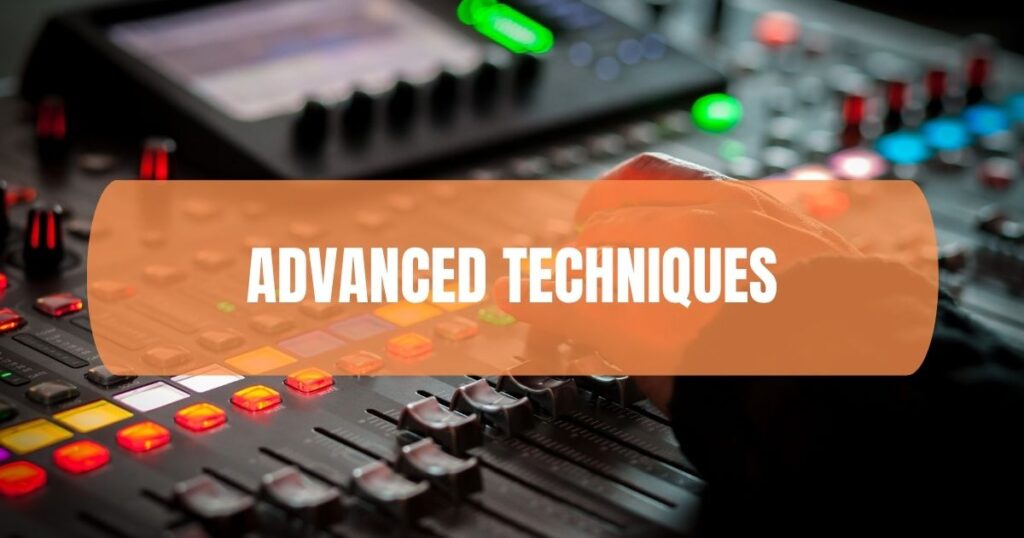
Advanced Techniques For Improving Soundcheck
– Choosing the Right Sound Check Song
– Using Soundcheck to Rehearse Songs
– Incorporating In-Ear Monitors.
– Experimenting with Different Sound Effects
– Modifying Instrument and Mic Placement for Optimal Sound
To get the most out of soundcheck, musicians should consider implementing some of these advanced techniques.
Choosing The Right Sound Check Song
One key way to improve your soundcheck is by selecting an appropriate song for the process.
Aside from just technical considerations when picking a tune for soundcheck, you should also use this time to experiment with different settings or sounds that can be used in more than one song during a performance.
Adjusting mic placement or rehearsing intros or transitions using a specific piece will help create consistency throughout the entire night without having to take up too much extra time playing samples from various songs during soundcheck itself.
Using Soundcheck To Rehearse Songs
By using soundcheck as part of your rehearsal process, you can identify and correct technical issues with equipment or instrument placement, adjust levels on mic or amp settings, and tweak EQs until each song sounds right.
For example, if you’re trying out a new piece of gear, such as in-ear monitors, onstage for the first time at a show, it is important to ensure everything functions properly during soundcheck.
This also gives your bandmates time to adjust to hearing their own instrument through them while onstage, so they don’t have any surprises when the lights come up! Similarly, practising one specific song from start to finish during soundcheck will give the entire band an idea of what needs to be adjusted—diegetic cracking cables could easily be detected then instead of suddenly cropping up in between sets.
Incorporating In-Ear Monitors
Incorporating in-ear monitors into soundchecks help musicians reach the highest level of performance.
In-ear monitors provide a studio-quality sound experience, allowing musicians to make micro-adjustments to their mix from the stage, giving them greater control and more confidence during their performance.
More importantly, since they are placed inside ear canals instead of behind an amplifier stack, bad feedback and SPL levels characteristic of traditional monitoring systems is eliminated.
Some of the best acts in music today use in-ear monitors such as Elton John, Madonna, and Coldplay have all embraced this technology to exceptional success when performing live shows.
Experimenting With Different Sound Effects
Sound effects such as delay, reverb, chorus, flanger, distortion/overdrive and phaser can help you find more interesting ways of playing the same song night after night while helping prevent any monotony that could arise from performing the same setlist again and again.
Taking things a step further by combining multiple effects also allows you to really explore all the possibilities available when designing sounds for your set.
Famous musicians such as David Bowie famously used sound effect pedals throughout his career in order to maintain sonic diversity within his recorded music, whilst others like John Mayer would push their gear into unusual territories in search of inspiring new sounds on stage.
Modifying Instrument And Mic Placement For Optimal Sound
During soundcheck, instrument and mic placement is essential for getting the best live sound.
The most successful approach for achieving optimal mic placement builds on the basic rule-of-thumb protocols already in place:
adjust height and angle of microphones according to instruments playing distance; carefully ‘listen around’ concentrating on mics more than speakers;
add/remove mic(s) according to needs while experimenting with covers, in order to reduce spill between extreme dynamics sections during the performance, like vocals having too many other instruments sounds drowning them over into the house PA Mix.
Additionally, test different placements for instruments relative to/relating to each respective recorded track (tuning requirements).
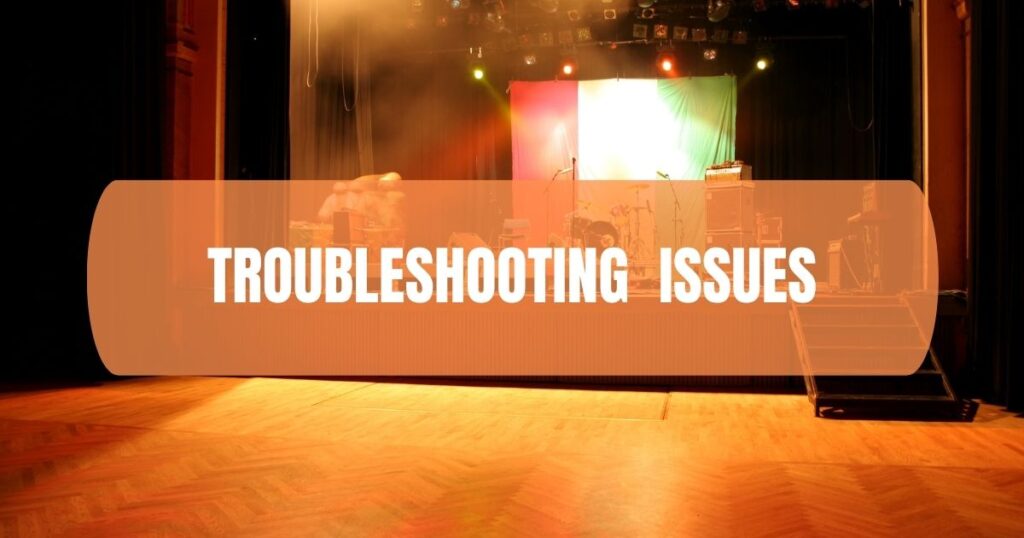
Troubleshooting Soundcheck Issues
– Addressing Feedback and Echo
– Balancing Volume Levels
– Correcting Instrument and Mic Placement
For more tips on troubleshooting soundcheck issues, as well as advanced techniques for improving soundcheck that will help your performance come alive on stage!
Addressing Feedback And Echo
Tackling feedback and echo problems during soundcheck can seem like an impenetrable task to many musicians.
Fortunately, there are several practical techniques that can help you quickly identify and eliminate the source of the issue.
The first step is to have a plan in place that everyone agrees on before proceeding with soundcheck.
This will ensure that everybody involved is working towards the same goals, and it will also prevent frustration if something goes wrong.
Once all your instruments, equipment and microphones are set up onstage for a gig or practice session, it’s time to begin addressing feedback issues then move onto mixing levels.
Doing this one channel at a time reduces the possibility of creating additional echoes due to overwhelming volume levels from multiple sources.
It’s important to remember not only balance each instrument’s individual mix but also how they interact together when combined onstage – this could involve making adjustments in EQ settings or adjusting each channel’s level accordingly with software or hardware controls available in most modern PA systems .
To pinpoint where exactly any undesirable feedback may be originating from, start listening to each microphone individually – making sure no other channels are playing while doing so – moving as close as possible until any kind of echoey effect is audible (or using headphones).
Once identified, slowly reduce its gain/volume lower than the threshold needed for feedback; usually around 3dB down helps .
To further limit unwanted noise, use dedicated software found on some FOH mixers, such as low-cut filters , phase inverters , auto-ducking for automated noise reduction etc .
Balancing Volume Levels
Balancing the sound levels between all the instruments and vocal mics is a huge part of soundcheck, often becoming one of its trickier elements.
To make sure your audience receives an enjoyable performance – and that you maintain your hearing – it’s essential to get this right.
If not, things can quickly crumble as one instrument dominates over another, and feedback begins to spoil what should have been a stunning show.
To make debugging easier during soundchecks, it’s important for musicians to ensure that each member has a dedicated monitor mix with proper mono or stereo separation, enabling them to accurately adjust their own level.
As such, having an experienced audio engineer who knows how high frequencies interact differently than mids or lows becomes key once again.
Correcting Instrument And Mic Placement
Even small tweaks, such as adjusting mic stands or putting an instrument slightly closer or farther away from the monitor speakers, can drastically improve the overall sound of the band.
One way to make sure everything is positioned optimally is to use in-ear monitors (IEMs) instead of traditional floor wedges, which provide greater control over each musician’s individual tone.
As well as giving you more versatility when it comes to placement, IEMs reduce the feedback that can occur if mics are spaced too close together next to each other – creating a cleaner-sounding mix that won’t suffer from muddy frequencies when trying harder passages on stage.
All in All
The soundcheck is the most important part of a live performance. It ensures that all the instruments and microphones are properly set up before the show begins.
Whether it’s your first time doing a soundcheck or you’re a seasoned veteran, using these tips can make sure that your experience goes smoothly and efficiently.
From being prepared and organized to communicating effectively with engineers, making sure that everything is placed correctly on stage, to minimizing common mistakes like poor communication or leaving things until the last minute, these steps can help musicians get their sound right for their performances.
Lastly, remember to bring an extra person around for troubleshoots as they give fresh ideas on how to improve your sound check process without wasting too much time.
Hope that helps you with your performance!
Cheers, Josh
Hello, I’m Josh, and I’ve been honing my graphic design skills for almost 15 years now, catering to the needs of bands and businesses alike. What really fascinates me is the business aspect of the music industry. In addition to my design work, I also happen to play the Hammond organ, and I strive to share my knowledge through helpful articles that I write exclusively for you all!


